Labrador puppies are known for their friendly and highly trainable nature. However, when it comes to house training, it can be a bit challenging for both the puppy and its owner. In this blog post, we will explore some effective strategies to house train a Labrador puppy. From establishing a routine to using positive reinforcement techniques, these tips will help you guide your furry friend towards proper toilet etiquette.
Establishing a Routine
– One of the first steps in house training your Labrador puppy is to establish a consistent routine. Dogs thrive on consistency, so having a set schedule will help them understand when and where they should go to relieve themselves.
– Take your puppy outside to a designated spot in your yard regularly, especially after meals, waking up from a nap, or after playtime. This will teach them that this is the appropriate place to eliminate.
– Early in the training process, it might be helpful to take your puppy out every hour or so, gradually increasing the time between potty breaks as they become better at holding their bladder.
– Keep in mind that puppies have limited bladder control, so they may need to go out more frequently than adult dogs.

Using Positive Reinforcement
– Positive reinforcement is a key component of house training any dog, including Labrador puppies. By rewarding your puppy for going to the bathroom in the right place, you are reinforcing the desired behavior.
– When your puppy eliminates in the designated spot, offer plenty of praise, petting, and even treats. This positive association will encourage them to repeat the behavior in the future.
– Avoid using punishment or scolding when accidents happen. Negative reinforcement can create anxiety or fear in your puppy, which can hinder the training process.
– Instead, be patient and consistent with your training. Remember that accidents are a normal part of the learning process, and it takes time for puppies to develop proper bathroom habits.
Managing Accidents
– Despite your best efforts, accidents are bound to happen during the house training process. The key is to handle them in a calm and composed manner.
– When you catch your puppy in the act of eliminating indoors, gently interrupt them with a verbal cue, such as “Oops” or “No,” and immediately take them outside to finish.
– Clean any accidents thoroughly with an enzymatic cleaner that breaks down the odor and discourages your puppy from using that spot again.
– Avoid using ammonia-based cleaners, as they can actually attract your puppy to eliminate in the same area.
Preventing Access to Restricted Areas
– To avoid accidents and speed up the house training process, it’s crucial to restrict your puppy’s access to areas of the house where they are more likely to have accidents.
– Use baby gates or closed doors to keep your puppy confined to one area or a smaller part of the house until they have developed better bathroom habits.
– As your puppy becomes more reliable with their potty training, you can gradually give them more freedom to roam around the house.
FAQs
Q1. At what age should I start house training my Labrador puppy?
A1. It is recommended to start house training your Labrador puppy around 8 to 12 weeks of age when they have better control over their bladder and bowel movements.
Q2. How long does it usually take to house train a Labrador puppy?
A2. The duration of house training can vary from puppy to puppy, but with consistent training and positive reinforcement, most Labrador puppies can be reliably house trained within a few months.
Q3. What if my Labrador puppy is still having accidents even after months of training?
A3. If your Labrador puppy is still having accidents after months of training, it is important to rule out any underlying medical conditions that may be causing the issue. Consult your veterinarian for a thorough examination.
Q4. Can I use puppy pads or indoor potty systems for house training my Labrador?
A4. While puppy pads and indoor potty systems can be useful in certain situations, they may prolong the training process as they teach your puppy to eliminate indoors. It is generally more effective to focus on outdoor training from the beginning.
Q5. Are there any additional resources or tools I can use to assist with house training my Labrador puppy?
A5. Yes, there are several resources and tools available that can complement your house training efforts. Crate training can help with managing your puppy’s behavior and preventing accidents when you cannot supervise them. Additionally, using a clicker and treats for positive reinforcement can enhance the training experience.
In conclusion, house training a Labrador puppy requires patience, consistency, and positive reinforcement. By establishing a routine, using positive reinforcement techniques, managing accidents calmly, and preventing access to restricted areas, you can successfully guide your puppy towards proper toilet etiquette. Remember to be patient and celebrate every small success along the way. For more information and professional assistance with house training your Labrador puppy, visit petwah.com.
PetWah. Training your furry friend the right way!




%20-%20Copy.png)

.jpg)
.jpg)